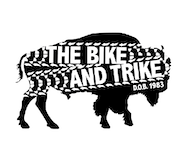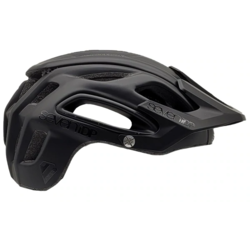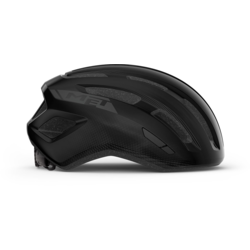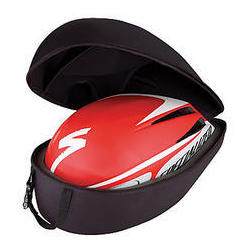Buyer's Guide To Bicycle Helmets
WHEN WE SELL A BICYCLE, we always ask whether you have a good helmet, too. Why? Because we know that head protection is the most important safeguard when cycling. In fact, according to the Bicycle Helmet Safety Institute, if they'd been wearing helmets, 90 percent of bicyclists who were seriously injured or died in accidents in recent years would have survived with treatable injuries.
The thing that makes helmets so important is how high your head is above the ground when you're riding. That's a long way to fall and quite an impact if you strike your head. Fortunately, all our helmets offer outstanding protection. They're even tested by the Consumer Product Safety Commission (CPSC) to ensure that they'll do their job. Here are some guidelines for choosing from the many models and styles we carry.
Features and Benefits
 Apart from their life-saving potential, helmets provide other benefits. One of the most surprising is their ability to cool your head. While this may seem counterintuitive, better helmets actually insulate the head from heat. They provide shade, of course. And, they're made of polystyrene, which is similar to what coolers are made of; a foam-like material that keeps heat out. Also, modern helmets venting systems force air through providing a constant cooling breeze. Tests have shown that these features actually make a helmeted rider cooler than a bareheaded one, even on a hot day or tough climb.
Apart from their life-saving potential, helmets provide other benefits. One of the most surprising is their ability to cool your head. While this may seem counterintuitive, better helmets actually insulate the head from heat. They provide shade, of course. And, they're made of polystyrene, which is similar to what coolers are made of; a foam-like material that keeps heat out. Also, modern helmets venting systems force air through providing a constant cooling breeze. Tests have shown that these features actually make a helmeted rider cooler than a bareheaded one, even on a hot day or tough climb.
Another great feature, especially for off-road riding or touring on a bike with an upright seating position, is a visor. These keep sun out of the eyes improving visibility by reducing glare and cutting down on sunburn. Plus, when you're riding off road and the sun is low in the sky, the visor helps block rays flashing strobe-like through the trees. They'll also knock away small branches that might hit you in the face as you ride past on narrow trails.
Modern helmets are also brightly colored, a clear signal to motorists. And because they're on the top of your head, the highest point on your body, they make you much more visible in traffic.
Find a Fine Fit
Head and helmet shapes vary so the most important rule is to try on several models and brands to find the type that fits your head best. Start by trying on any helmet to see what size you are. Or you can measure your head just above the eyebrows with a tape measure to get an idea (small is roughly 20 to 22 inches; medium: 22 to 23.5 inches; and large: 23.25 to 24.5 inches).
Usually helmets come in at least three sizes depending on the manufacturer. You're looking for one that offers a snug fit. Ask us for help if you have questions. We're happy to help and we have the experience to point you toward a helmet that's right for your head shape, riding style and budget.
Generally speaking, there are round and oval heads and helmet shapes that match. You can tell when the helmet fits right. It'll feel snug all the way around. To test it, try moving the helmet side-to-side and front-to-back. If there's more play side-to-side than front-to-back, you've probably tried on a round-shape helmet and you probably have a more oval-shaped head.
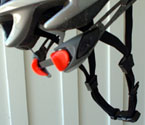 Keep in mind that all helmets come with fitting kits. These pads adhere to the inside of the helmet to customize it to your head. The helmet however, should almost fit your head before you add any fitting pads. Otherwise, you may have to put in a lot of pads to get it to fit, which will compromise the fit. In a really good fit, you may need no pads or only two pads, one on either side or end to snug the helmet a bit.
Keep in mind that all helmets come with fitting kits. These pads adhere to the inside of the helmet to customize it to your head. The helmet however, should almost fit your head before you add any fitting pads. Otherwise, you may have to put in a lot of pads to get it to fit, which will compromise the fit. In a really good fit, you may need no pads or only two pads, one on either side or end to snug the helmet a bit.
Fit doesn't depend only on pads and helmet size. Most helmets today include retention devices, which are comprised of wide straps or plastic web-like retainers built into the back of the helmet that hold the base of your head. These are adjustable to fine-tune fit. And, when the retention device is properly set, it helps hold the helmet in place. This is a great feature when you're riding over bumpy terrain.
Selecting Your Helmet
You can spend from $30 to $200 for a bicycle helmet today. Surprisingly, almost all quality models protect equally well. How can you tell a good one? Look for a sticker inside the helmet that says CPSC. If it has this sticker, the helmet has passed rigid testing standards. All our helmets have passed these tests.
Consider how you'll use the helmet, too. As we mentioned, a visor is a handy feature for off-road use. You may not want it for road use, however, because if you ride with your head down, the visor can block vision a bit. Many helmets today come with removable visors though, which allow you to use the same helmet and customize it for the conditions.
As you spend more for a helmet, you don't get more protection. What you get is more vents for increased cooling, lighter weight, which makes an energy-saving difference on long rides, and slightly more advanced strap and retention systems. Also, better helmets feature molding technology that incorporates the helmet's hard shell into the polystyrene body. This helps keep the helmet in good condition longer through daily wear and tear.You might feel a difference worth paying for by trying on these helmets and if so, you should buy one. Usually, the more you ride, the more you'll notice the design enhancements.
When trying on helmets, after fit, look for comfortable straps and ones that have a secure locking device (so they don't change adjustment all the time). You want soft pads too that can't chafe your head, an overall design that appeals to you, and a price that suits your budget. Remember: you don't have to spend a lot. You'll find very nice, perfectly safe helmets that look almost identical to the big-buck models in the $45 to $90 price ranges.
Other Considerations
When you get the helmet home, don't ignore the owner's manual. Study it. Even if we adjusted the helmet to your head, it's important for you to understand how the helmet should fit and how to adjust it because as you wear the helmet, the straps may change adjustment.
 Many people make the mistake of tipping the helmet back on the head when adjusting it because they think it'll fell cooler that way (see the girl's helmet in the photo). That's a big mistake because a tipped-back helmet can't protect your face in a crash.
Many people make the mistake of tipping the helmet back on the head when adjusting it because they think it'll fell cooler that way (see the girl's helmet in the photo). That's a big mistake because a tipped-back helmet can't protect your face in a crash.
The helmet must sit squarely on the head (see the policewoman's photo) so that the front of the helmet will hit first if you go over the handlebars. The straps are what adjust the helmet so it will remain in this position naturally when you put it on. Adjusted correctly, you should be able to lightly tug on the helmet and it shouldn't move or tip excessively. It should want to return to the proper position automatically. Also, the small strap buckles on either side should rest just beneath the ear lobes. Instructions in the owner's manual explain in detail how to adjust the straps for the proper helmet fit. Be sure to ask us for help if you're not sure.
Another important thing you can find out about in the manual is the guarantee. Some makers offer replacement policies for crashed helmets. You won't get a helmet for free but you may save some money by returning your helmet with a letter describing what happened.
Finally, helmets don't last forever. Helmet manufacturers recommend getting a new helmet at least every 5 years. This is important for your protection in a crash. Helmet materials break down slightly over the years and helmets just naturally take a beating in use as you toss them in the truck, drop them and ride.
We look forward to showing you some helmets!
